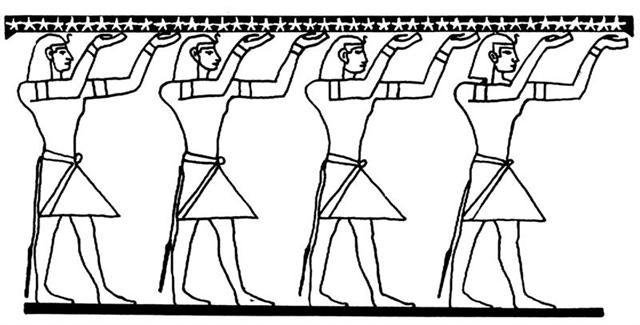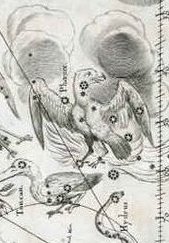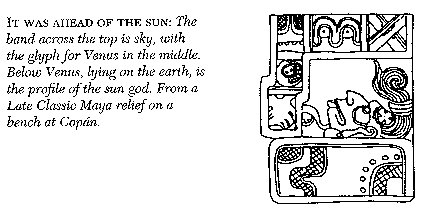The foregoing indicates that a glyph text cannot be read mechanically, it is not like an alphabetic text. ... 'Most ingenious Thoth', said the god and king Thamus, 'one man has the ability to beget arts, but the ability to judge of their usefulness or harmfulness to their users belongs to another; and now you, who are the father of letters, have been led by your affection to ascribe to them a power the opposite of that which they really possess. For this invention will produce forgetfulness in the minds of those who learn to use it, because they will not practise their memory. Their trust in writing, produced by external characters which are no part of themselves, will discourage the use of their own memory within them. You have invented an elixir not of memory, but of reminding; and you offer your pupils the appearance of wisdom, not true wisdom, for they will read many things without instruction and will therefore seem to know many things, when they are for the most part ignorant and hard to get along with, since they are not wise, but only appear wise.' Therefore we should not worry too much about the possibility of a break in the sequence of heliacal stars. But it is necessary to count:
181 could be a Sign of the position of 'Sirius' in a Sun calendar. For instance was Antares rising with the Sun 181 days after Aldebaran - Antares was like Sirius, he was 'Sirius'. Furthermore, 471 - 181 = 290. Beyond heliacal Sirius would come the declining (back part) of the Sun - or its opposite (the complementary view) as regarded from a position south of the equator - where the dark June month would be followed by Sky being pushed up higher and higher: ... It must be admitted, however, that the task of raising the sky was not always a long and arduous one. In the New Hebrides of Melanesia the sky was formerly so low overhead that a woman who was pounding roots in a mortar happened to strike the sky with her pestle. Greatly annoyed at the interruption she looked up and cried angrily, 'Go on up higher!' Whereat the sky meekly obeyed her. What actually happened probably was that the woman struck the low house roof with her pestle and cried angrily to her husband, 'If you don't raise that roof higher, I won't cook you another meal!' thus giving a strong impuls to the development of the science of architecture ...
We could expect 4 sky raisers to follow after Sirius. The Egyptian picture below has 42 stars in the sky roof, supported by 7 (not 8) hands (the last figure is streching his neck and using his head instead). And there are 15 (not 16) rings around the supporting arms, because the 7th arm has only 1 ring - beyond ring number 13 there is a vacancy:
... 'Among the multitude of gods worshipped by these people were four whom they called by the name Bacab. These were, they say, four brothers placed by God when he created the world at its four corners to sustain the heavens lest they fall.' (Diego De Landa according to Graham Hancock in his Fingerprints of the Gods.) 'In the ms. Ritual of the Bacabs, the cantul kuob [the suffix '-ob' indicates plural], cantul bacabob, the four gods, the four bacabs, occur constantly in the incantations, with the four colors, four directions, and their various names and offices.' (William Gates, An Outline Dictionary of Maya Glyphs.) '... This connects up the present section with the beginning of the 'sacred tonalamatl', at the Spring equinox with the Mayas as with the Mexicans, and in the center of the 364-day year (52 days of which preceded and 52 followed the tonalamatl or tzolkin), ruled by its 91-day quarters by the Four Bacabs, whose quarternary repetition (in the 1820-day period) we have thus verified ...' (Gates, a.a.) The curved backs of the 4 figures at the beginning of July could possibly indicate how on Easter Island the Sun never went as high as in their ancient homeland. ... They all sat down and rested [on the plain of Oromanga], when suddenly they saw that a turtle had reached the shore and had crawled up on the beach. He [Ira] looked at it and said, 'Hey, you! The turtle has come on land!' He said, 'Let's go! Let's go back to the shore.' They all went to pick up the turtle. Ira was the first one to try to lift the turtle - but she didn't move. Then Raparenga said, 'You do not have the necessary ability. Get out of my way so that I can have a try!' Raparenga stepped up and tried to lift the turtle - but Raparenga could not move her. Now you spoke, Kuukuu: 'You don't have the necessary ability, but I shall move this turtle. Get out of my way!' Kuukuu stepped up, picked up the turtle, using all his strength. After he had lifted the turtle a little bit, he pushed her up farther. No sooner had he pushed her up and lifted her completely off the ground when she struck Kuukuu with one fin. She struck downward and broke Kuukuu's spine. The turtle got up, went back into the (sea) water, and swam away. All the kinsmen spoke to you (i.e. Kuukuu): 'Even you did not prevail against the turtle!' In Gb7-2 we can perceive another figure 'leaning forward' (cfr the Sirius glyph 10 positions earlier), but here I have changed my reading frame of right ascension reference, changed it from 0h at the time of Hyades II to 0h at the time of rongorongo - when Rogo was at the 2nd Spout (at the back of the head of Andromeda).
Tamaiti at 414 (counting also the empty glyph space at the beginning of side a) could refer to March 26 as the first day after equinox (using the Roman custom of positioning the equinox), and this tamaiti could have represented the first day of the new year, the new year child (5 days after Rogo).
The preceding (and complementary) Janus figure was meant to indiate the old one, therefore leaning forward (as old people tend to do). The Sirius glyph (Gb6-20) is also leaning forward, maybe because it marked the last day of the old Jupiter (Father of Light) month.
... Yes, said the maiden.She stretched out her right hand, up there in front of the bone. And then the bone spit out its saliva, which landed squarely in the hand of the maiden. And then she looked in her hand, she inspected it right away, but the bone's saliva wasn't in her hand. It is just a sign I have given you, my saliva, my spittle. This, my head, has nothing on it - just bone, nothing of meat. It's just the same with the head of a great lord: it's just the flesh that makes his face look good. And when he dies, people get frightened by his bones. After that, his son is like his saliva, his spittle, in his being, whether it be the son of a lord or the son of a craftsman, an orator. The father does not disappear, but goes on being fulfilled. Neither dimmed nor destroyed is the face of a lord, a warrior, craftsman, an orator. Rather, he will leave his daughters and sons. So it is that I have done likewise through you. Now go up there on the face of the earth; you will not die. Keep the word. So be it, said the head of One and Seven Hunaphu - they were of one mind when they did it ... The calendar year was here (in line Gb7) beginning - I suggest - not after the solstice but after the equinox, an effect of the precession since the time of Taurus, when late JANUARY (the Janus month) could have been the last part of the old year. 8 days from June 27 (177 + 1) to July 5 (185 + 1) were perhaps regarded as a kind of dark underground 'week' corresponding to the 8 nights when Venus was invisible before she 'went up on the face of the earth' - returned as Morning Star. There the 'child' would sprout.
But if this was so, then we maybe should search in the text for those 50 nights when Venus was invisible before returning as Evening Star. This place is known for us, although a sense of beauty may have made its measure equal to 'the square' of the earth turtle (Pawahtun):
7 * 7 = 314 - 265 and 7 * 7 is also expressed by SEPTEM-BER 7 (250 as in the Mayan evening star period):
Hotu A Matua arrived to Easter Island in Tangaroa Uri 15, which would make sense if we could equate this date with 'October 15 - he came when Venus returned as Evening Star. ... And here is the dawning and showing of the sun, moon, and stars. And Jaguar Quitze, Jaguar Night, Not Right Now, and Dark Jaguar were overjoyed when they saw the sun carrier. It came up first. It looked brilliant when it came up, since it was ahead of the sun ...
... What might lie behind this statement is revealed by a contemporary Mopán Maya tale in which Lord K'in (the sun) goes from his home in the east to the center of the sky and then back to the east again; it appears that he goes clear across the sky because he has placed a mirror at its center. To interpret the movements of the sun in this manner is to model it on Venus as morning star, which both rises and sets in the east ... |
|||||||||||||||||||||||||||||||||||||||||||||||||||||||||||||||||||||||||||||||||||||||||||||||||||||||||||||||||||||||||||||||||||||||||||||||||||||||||||||||||||||||||||||||||||||||||||||||||||||||||||||||||||||||||||||||||||||||||||||||||||||||||||||











